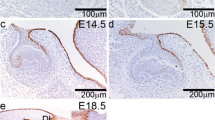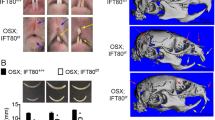Abstract
The activation of Wingless-type (Wnt)/β-catenin signaling is of fundamental importance in organogenesis. Wnt signaling is also known to regulate signaling crucial for tooth development. However, the underlying mechanism of Wnt activation or inhibition remains largely unknown. Here, we demonstrate that Wnt inhibitory factor 1 (Wif1), a secreted Wnt antagonist, localizes to the dental epithelium and mesenchyme during early tooth development. Specifically, Wif1 is strictly expressed in the enamel knot at embryonic day 14.5 (E14.5) and E16.5. The functional significance of Wif1 during tooth morphogenesis remains to be clarified. Our results reveal that the promotion of apoptosis by the knockdown of Wif1 leads to a delay in an early event during tooth development. This study therefore provides novel insights into the role of Wif1 and validates Wif1 as a potent target in WNT signaling during tooth development. We suggest that the enamel knots are central regulators of tooth development. Furthermore, Wif1 localizes to the enamel knot in which Wif1 regulates apoptosis by mediating and regulating Wnt-β-catenin signaling. Thus, Wif1 plays an essential role in tooth development.




Similar content being viewed by others
References
Ahn Y, Sanderson BW, Klein OD, Krumlauf R (2010) Inhibition of Wnt signaling by Wise (Sostdc1) and negative feedback from Shh controls tooth number and patterning. Development 137:3221–3231
Aurrekoetxea M, Lopez J, García P, Ibarretxe G, Unda F (2012) Enhanced Wnt/β-catenin signalling during tooth morphogenesis impedes cell differentiation and leads to alterations in the structure and mineralisation of the adult tooth. Biol Cell 104:603–617
Fjeld K, Kettunen P, Furmanek T, Kvinnsland IH, Luukko K (2005) Dynamic expression of Wnt signaling-related Dickkopf1, −2, and −3 mRNAs in the developing mouse tooth. Dev Dyn 233:161–166
Hsieh JC, Kodjabachian L, Rebbert ML, Rattner A, Smallwood PM, Samos CH, Nusse R, Dawid IB, Nathans J (1999) A new secreted protein that binds to Wnt proteins and inhibits their activities. Nature 398:431–436
Jarvinen E, Salazar-Ciudad I, Birchmeier W, Taketo MM, Jernvall J, Thesleff I (2006) Continuous tooth generation in mouse is induced by activated epithelial Wnt/beta-catenin signaling. Proc Natl Acad Sci U S A 103:18627–18632
Jia S, Zhou J, Gao Y, Baek JA, Martin JF, Lan Y, Jiang R (2013) Roles of Bmp4 during tooth morphogenesis and sequential tooth formation. Development 140:423–432
Kansara M, Tsang M, Kodjabachian L, Sims NA, Trivett MK, Ehrich M, Dobrovic A, Slavin J, Choong PF, Simmons PJ, Dawid IB, Thomas DM (2009) Wnt inhibitory factor 1 is epigenetically silenced in human osteosarcoma, and targeted disruption accelerates osteosarcomagenesis in mice. J Clin Invest 119:837–851
Kawano Y, Kypta R (2003) Secreted antagonists of the Wnt signalling pathway. J Cell Sci 116:2627–2634
Keil KP, Mehta V, Branam AM, Abler LL, Buresh-Stiemke RA, Joshi PS, Schmitz CT, Marker PC, Vezina CM (2012) Wnt inhibitory factor 1 (Wif1) is regulated by androgens and enhances androgen-dependent prostate development. Endocrinology 153:6091–6103
Kim JY, Mochizuki T, Akita K, Jung HS (2003) Morphological evidence of the importance of epithelial tissue during mouse tongue development. Exp Cell Res 290:217–226
Lammi L, Arte S, Somer M, Jarvinen H, Lahermo P, Thesleff I, Pirinen S, Nieminen P (2004) Mutations in AXIN2 cause familial tooth agenesis and predispose to colorectal cancer. Am J Hum Genet 74:1043–1050
Liu F, Millar SE (2010) Wnt/beta-catenin signaling in oral tissue development and disease. J Dent Res 89:318–330
Liu F, Chu EY, Watt B, Zhang Y, Gallant NM, Andl T, Yang SH, Lu MM, Piccolo S, Schmidt-Ullrich R, Taketo MM, Morrisey EE, Atit R, Dlugosz AA, Millar SE (2008) Wnt/beta-catenin signaling directs multiple stages of tooth morphogenesis. Dev Biol 313:210–224
Livak KJ, Schmittgen TD (2001) Analysis of relative gene expression data using realtime quantitative PCR and the 2-Delta Delta C(T) method. Methods 2001:402–408
Lohi M, Tucker AS, Sharpe PT (2010) Expression of Axin2 indicates a role for canonical Wnt signaling in development of the crown and root during pre- and postnatal tooth development. Dev Dyn 239:160–167
Matalova E, Dubska L, Fleischmannova J, Chlastakova I, Janeckova E, Tucker AS (2010) Cell proliferation and apoptosis in the primary enamel knot measured by flow cytometry of laser microdissected samples. Arch Oral Biol 55:570–575
Mostowska A, Biedziak B, Jagodzinski PP (2006) Axis inhibition protein 2 (AXIN2) polymorphisms may be a risk factor for selective tooth agenesis. J Hum Genet 51:262–266
Nelson WJ, Nusse R (2004) Convergence of Wnt, beta-catenin, and cadherin pathways. Science 303:1483–1487
Ng RC, Matsumaru D, Ho AS, Garcia-Barceló MM, Yuan ZW, Smith D, Kodjabachian L, Tam PK, Yamada G, Lui VC (2014) Dysregulation of Wnt inhibitory factor 1 (Wif1) expression resulted in aberrant Wnt-β-catenin signaling and cell death of the cloaca endoderm, and anorectal malformations. Cell Death Differ 21:978–989
Peterkova R, Lesot H, Peterka M (2006) Phylogenetic memory of developing mammalian dentition. J Exp Zool B Mol Dev Evol 306:234–250
Ramachandran I, Thavathiru E, Ramalingam S, Natarajan G, Mills WK, Benbrook DM, Zuna R, Lightfoot S, Reis A, Anant S, Queimado L (2012) Wnt inhibitory factor 1 induces apoptosis and inhibits cervical cancer growth, invasion and angiogenesis in vivo. Oncogene 31:2725–2737
Sarkar L, Sharpe PT (1999) Expression of Wnt signalling pathway genes during tooth development. Mech Dev 85:197–200
Schlüter H, Stark HJ, Sinha D, Boukamp P, Kaur P (2013) WIF1 is expressed by stem cells of the human interfollicular epidermis and acts to suppress keratinocyte proliferation. J Invest Dermatol 133:1669–1673
Thesleff I, Sharpe P (1997) Signalling networks regulating dental development. Mech Dev 67:111–123
Tucker A, Sharpe P (2004) The cutting-edge of mammalian development; how the embryo makes teeth. Nat Rev Genet 5:499–508
Tummers M, Thesleff I (2009) The importance of signal pathway modulation in all aspects of tooth development. J Exp Zool B Mol Dev Evol 312B:309–319
Wang XP, O’Connell DJ, Lund JJ, Saadi I, Kuraguchi M, Turbe-Doan A (2009) Apc inhibition of Wnt signaling regulates supernumerary tooth formation during embryogenesis and throughout adulthood. Development 136:1939–1949
Willert K, Brown JD, Danenberg E, Duncan AW, Weissman IL, Reya T, Yates JR 3rd, Nusse R (2003) Wnt proteins are lipid-modified and can act as stem cell growth factors. Nature 423:448–452
Wu D, Wong P, Li W, Vogel CF, Matsumura F (2011) Suppression of WIF-1 through promoter hypermethylation causes accelerated proliferation of the aryl hydrocarbon receptor (AHR) overexpressing MCF10AT1 breast cancer cells. Toxicology 285:97–103
Xu B, Chen C, Chen H, Zheng SG, Bringas P Jr, Xu M, Zhou X, Chen D, Umans L, Zwijsen A, Shi W (2011) Smad1 and its target gene Wif1 coordinate BMP and Wnt signaling activities to regulate fetal lung development. Development 138:925–935
Author information
Authors and Affiliations
Corresponding author
Additional information
This work was supported by the National Research Foundation of Korea (NRF) grant funded by the Korea government (MSIP) (No. NRF-2014R1A2A1A11050764).
Electronic supplementary material
Below is the link to the electronic supplementary material.
ESM 1
(DOCX 17 kb)
Supplementary Figure 1
(GIF 214 kb)
Rights and permissions
About this article
Cite this article
Lee, MJ., Kim, EJ., Li, L. et al. Roles of Wnt inhibitory factor 1 during tooth morphogenesis. Cell Tissue Res 362, 61–68 (2015). https://doi.org/10.1007/s00441-015-2170-3
Received:
Accepted:
Published:
Issue Date:
DOI: https://doi.org/10.1007/s00441-015-2170-3




